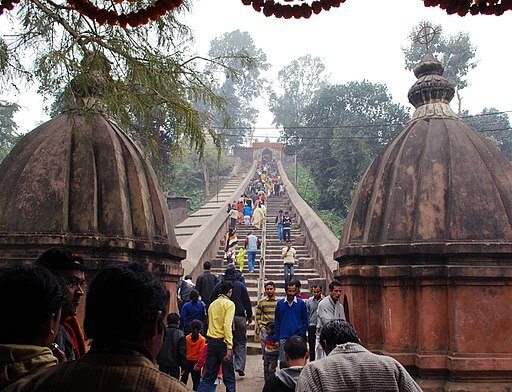The following publication from Global Peace Foundation describes a model of interfaith peacebuilding in India through Hajo, a community of Hindus, Buddhists, and Muslims who are making an effort to build inter-religious harmony for the sake of peace and shared prosperity.
By Tofica Ullah
Whenever any incident of religious tension rises to the surface after simmering for a long time or violent mobs set fire to places of worship we wonder if there could ever be any peaceful solution to all this violence. On 6 December 1992, such an outrage of communal hatred took place in India when a political rally turned violent. A large crowd of Hindu Kar Sevaks (activists) demolished the Babri Mosque, a sacred place of worship for Muslims since it was built in the 16thcentury, in the city of Ayodhya, in Uttar Pradesh, India.
The destruction of the Babri Mosque, as well as the destruction of numerous others that day, sparked Muslim outrage around the country, provoking several months of inter-communal rioting in which Hindus and Muslims attacked one another, burning and looting homes, shops and places of worship.
The ensuing riots spread to cities like Mumbai, Surat, Ahmedabad, Kanpur, Delhi, Bhopal and several others, eventually resulting in over 2000 deaths, mainly Muslim. The demolition and the ensuing riots were among the major factors behind the 1993 Mumbai bombings and many successive riots in the coming decade. Jihadi groups including the Indian Mujahideen cited the demolition of the Babri Mosque as a reason for their terrorist attacks.
A Light in the Darkness

Entrance of Hayagriva Madhab Mandir at Hajo Photo by: Jugal Bharali
During such a time when the whole country was going through turmoil of communal hatred, the Hajo community of Assam sought instead to spread the message of peace and harmony. Hajo has long been an ancient pilgrimage centre for the Hindus, Buddhists, and Muslims and considered to be a unique example of religious harmony. The place is full of mythological importance and is considered to be a highly sacred place by all the three religions. The small town is located on the banks of river Brahmaputra in the Kamrup district of Assam.
In a bid to send across the much-needed message of communal harmony, the Hayagriva Madhava Temple (Hindu, Buddhist) and the Powa Mecca (Muslim) of Hajo decided to carry out an interfaith procession. Even while the procession was initiated and supported by these three groups, it was one in which people of various religious groups were able to freely join and support.
A Model of Vasudhaiva Kutumbakam
The initiative that was taken up by the Hajo community in order to spread the message of communal harmony was not a one-day show. Since 1993, it has carried out this tradition every year. This year marks the 25th year of spreading such a message. Even the practical application of this message of communal harmony is deeply reflected through their daily activities.
There are a number of factors that makes Hajo remarkable as a model of interfaith and communal harmony. Historically, Hajo has been a central place of worship for a number of different faiths. Among the most notable spiritual sites include:
- The famous Hayagriva Madhav Temple is situated here, which is important to both the Hindu and Buddhist communities. The uniqueness of this temple lies in the fact that it preaches both Hinduism and Buddhism. And, quite interestingly, it is regarded as a Buddhist shrine because Lord Buddha is believed to have attained Nirvana here.
- Hajo is also home to a Muslim sacred site – Powa Mecca. Powa Mecca is a revered shrine for the Muslims. It was established in order to spread the fundamental message of Islam – Peace. It is believed to have been constructed with the very soil from Mecca.
- The Ganesh Temple is an important religious shrine of Hajo. It is also known as Deva Bhavana since it serves as the meeting point of all the deities of the area. This temple is quite ancient and has its own fair share of tourists.
- The Dhoparguri Satra is another significant religious place which teaches Vaishnavism, a set of beliefs founded by the great religious Guru, Srimanta Sankardeva. This major tourist attraction has been modeled on the lines of an Ashram and preaches the teachings of the great Srimanta Sankardev. Every year, devotees from the length and breadth of Assam throng the premises of this holy place in hordes.
It is perhaps this close intermingling of the different faith communities on an everyday basis that has made Hajo resilient in the face of conflict. The people of Hajo have — in the past well into today — shown unprecedented love and support for each other’s faith. As such, the Hajo community is able to live together understanding each other’s shared identity and common aspirations as members of the human family, a true model of the ideal of Vasudhaiva Kutumbakam (the world is one family).
It’s an oft-repeated statement that India is a land of unity in diversity. But, what many of us fail to fathom is that it has places like Hajo which have helped our country earn this title. With an unwavering sense of interfaith and communal harmony, Hajo is a model for religious unity and as an ideal guiding light to lead us towards greater peace and harmony.
The original post appears on Global Peace Foundation. Global Peace Foundation is an international non-sectarian, non-partisan, nonprofit organization, which promotes an innovative, values-based approach to peacebuilding, guided by the vision of One Family under God. GPF engages and organizes a global network of public and private-sector partners who develop community, national, and regional peace building models as the foundation for ethical and cohesive societies. Dr. Hyun Jin Preston Moon is founder and chairman of the Global Peace Foundation.
